MBA Organizational Behavior: Employability, Fit, and Leadership Report
VerifiedAdded on 2022/02/04
|24
|4117
|142
Report
AI Summary
This MBA assignment report provides a comprehensive analysis of organizational behavior, employability, and leadership, using UNICEF as a case study. The report begins with an employability profile, assessing the student's skills, knowledge, and values. It then analyzes two organizations: UNICEF (a good fit) and an unspecified second organization (a bad fit), examining their organizational settings, cultures, motivation and engagement strategies, leadership styles, decision-making processes, and approaches to organizational change. The report highlights UNICEF's functional organizational structure, decentralized nature, and values of respect, integrity, and accountability. It also explores the organization's efforts to promote motivation and engagement among its staff. The analysis of the two organizations allows for a comparative understanding of how different organizational characteristics impact employee behavior and overall success. The report integrates relevant theories and concepts from organizational behavior literature to support its findings and recommendations.
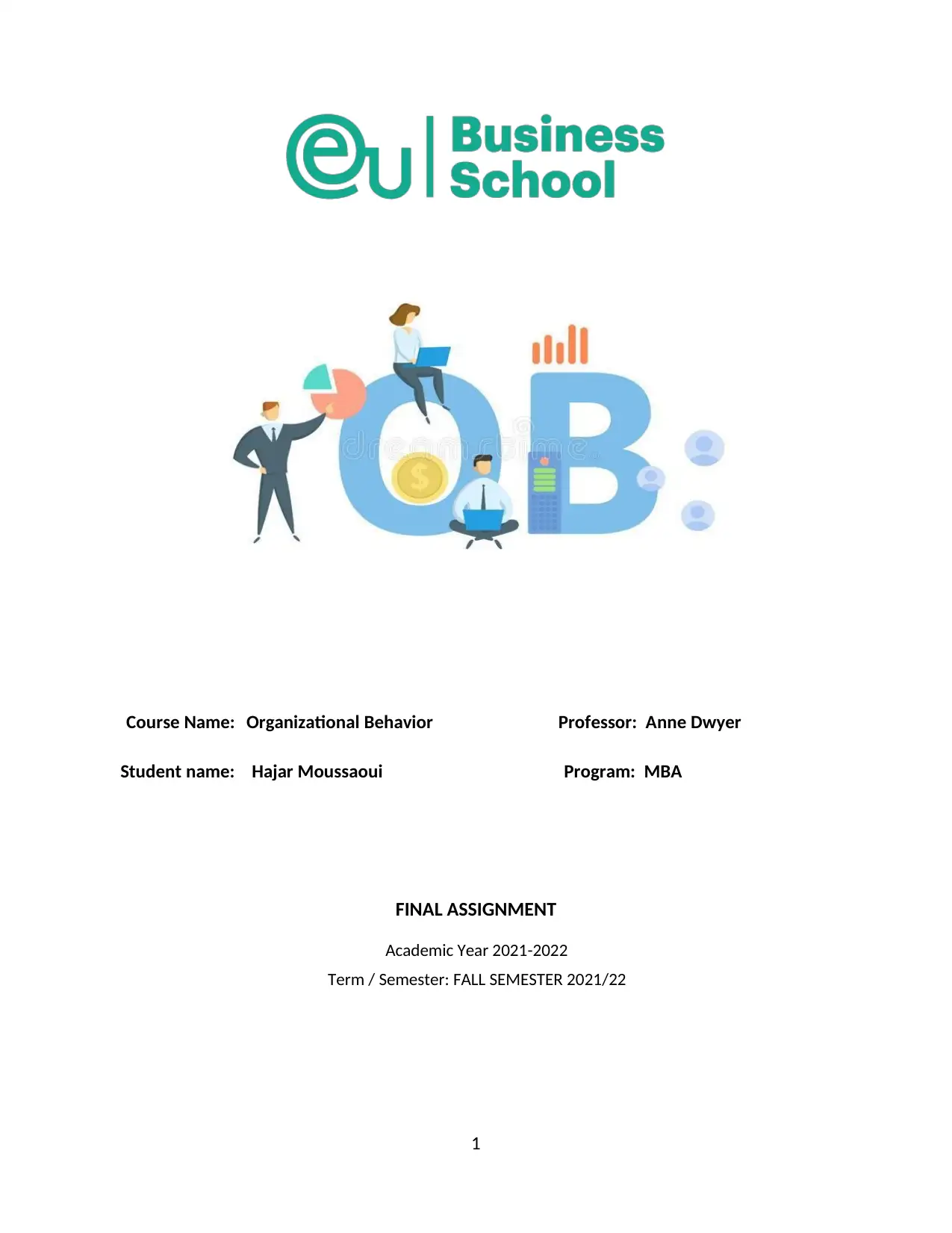
1
Course Name: Organizational Behavior Professor: Anne Dwyer
Student name: Hajar Moussaoui Program: MBA
FINAL ASSIGNMENT
Academic Year 2021-2022
Term / Semester: FALL SEMESTER 2021/22
Course Name: Organizational Behavior Professor: Anne Dwyer
Student name: Hajar Moussaoui Program: MBA
FINAL ASSIGNMENT
Academic Year 2021-2022
Term / Semester: FALL SEMESTER 2021/22
Paraphrase This Document
Need a fresh take? Get an instant paraphrase of this document with our AI Paraphraser
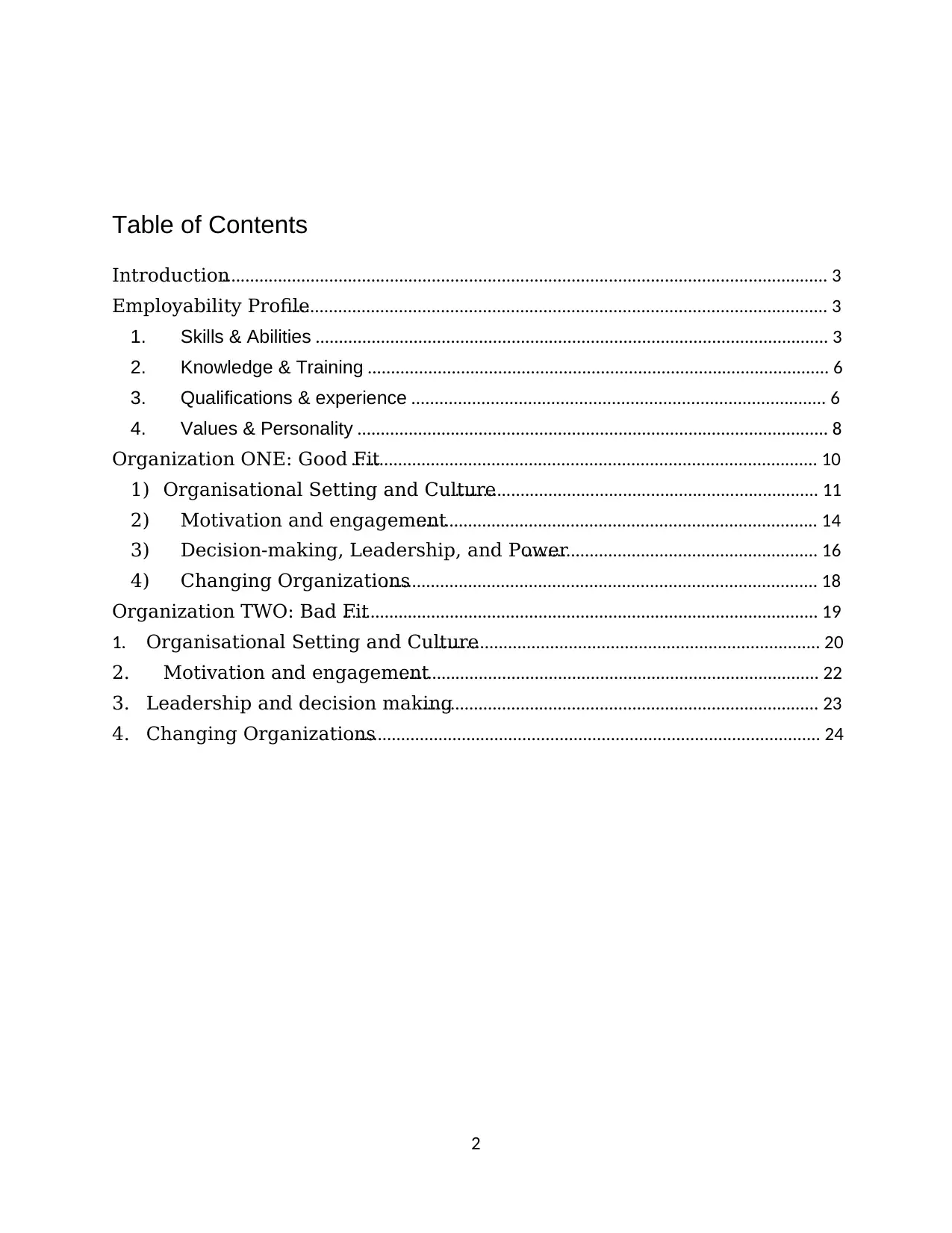
2
Table of Contents
Introduction.................................................................................................................................. 3
Employability Profile................................................................................................................... 3
1. Skills & Abilities .............................................................................................................. 3
2. Knowledge & Training ................................................................................................... 6
3. Qualifications & experience ......................................................................................... 6
4. Values & Personality ..................................................................................................... 8
Organization ONE: Good Fit.................................................................................................... 10
1) Organisational Setting and Culture.............................................................................. 11
2) Motivation and engagement...................................................................................... 14
3) Decision-making, Leadership, and Power............................................................... 16
4) Changing Organizations............................................................................................. 18
Organization TWO: Bad Fit...................................................................................................... 19
1. Organisational Setting and Culture.................................................................................. 20
2. Motivation and engagement.......................................................................................... 22
3. Leadership and decision making...................................................................................... 23
4. Changing Organizations..................................................................................................... 24
Table of Contents
Introduction.................................................................................................................................. 3
Employability Profile................................................................................................................... 3
1. Skills & Abilities .............................................................................................................. 3
2. Knowledge & Training ................................................................................................... 6
3. Qualifications & experience ......................................................................................... 6
4. Values & Personality ..................................................................................................... 8
Organization ONE: Good Fit.................................................................................................... 10
1) Organisational Setting and Culture.............................................................................. 11
2) Motivation and engagement...................................................................................... 14
3) Decision-making, Leadership, and Power............................................................... 16
4) Changing Organizations............................................................................................. 18
Organization TWO: Bad Fit...................................................................................................... 19
1. Organisational Setting and Culture.................................................................................. 20
2. Motivation and engagement.......................................................................................... 22
3. Leadership and decision making...................................................................................... 23
4. Changing Organizations..................................................................................................... 24
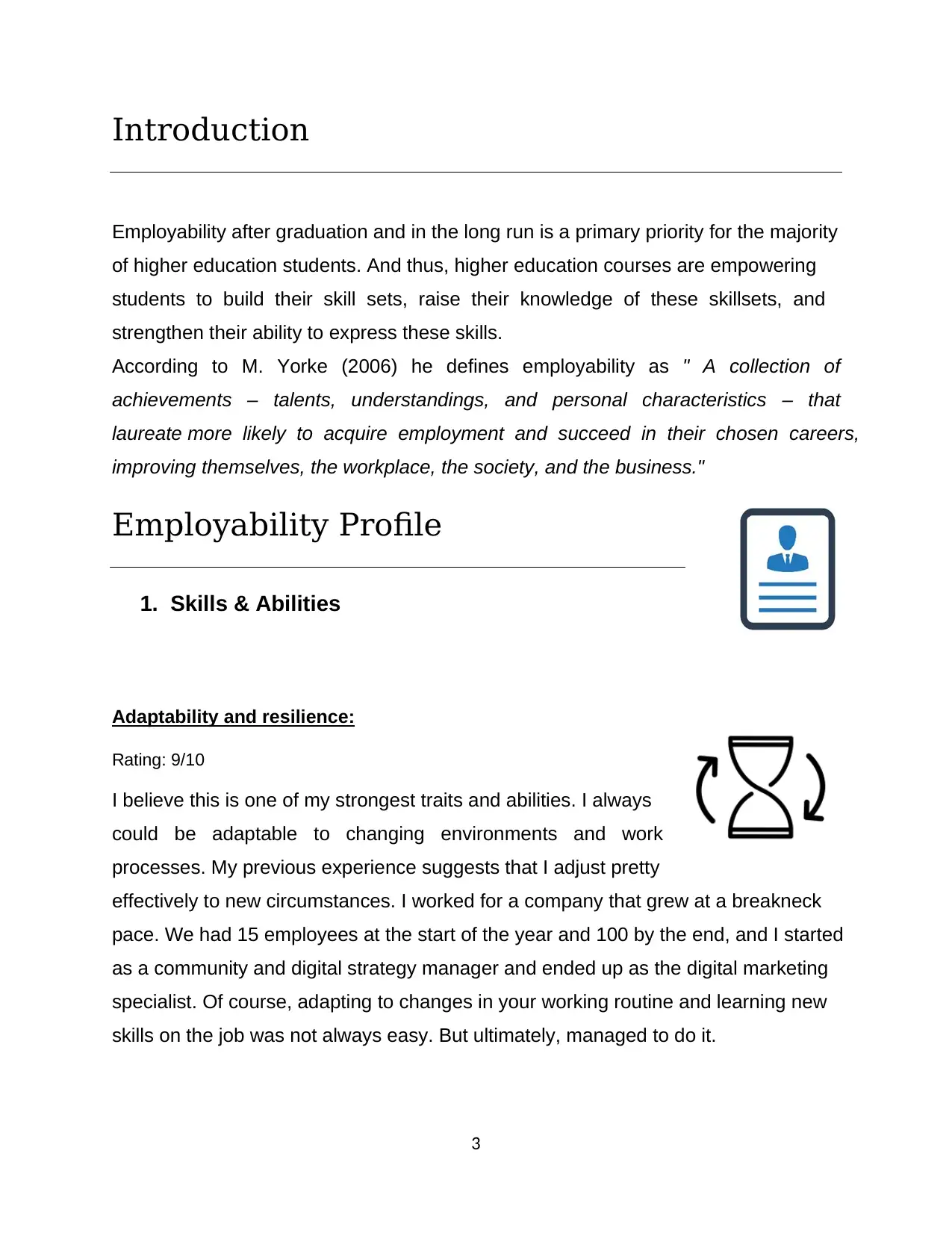
3
Introduction
Employability after graduation and in the long run is a primary priority for the majority
of higher education students. And thus, higher education courses are empowering
students to build their skill sets, raise their knowledge of these skillsets, and
strengthen their ability to express these skills.
According to M. Yorke (2006) he defines employability as " A collection of
achievements – talents, understandings, and personal characteristics – that
laureate more likely to acquire employment and succeed in their chosen careers,
improving themselves, the workplace, the society, and the business."
Employability Profile
1. Skills & Abilities
Adaptability and resilience:
Rating: 9/10
I believe this is one of my strongest traits and abilities. I always
could be adaptable to changing environments and work
processes. My previous experience suggests that I adjust pretty
effectively to new circumstances. I worked for a company that grew at a breakneck
pace. We had 15 employees at the start of the year and 100 by the end, and I started
as a community and digital strategy manager and ended up as the digital marketing
specialist. Of course, adapting to changes in your working routine and learning new
skills on the job was not always easy. But ultimately, managed to do it.
Introduction
Employability after graduation and in the long run is a primary priority for the majority
of higher education students. And thus, higher education courses are empowering
students to build their skill sets, raise their knowledge of these skillsets, and
strengthen their ability to express these skills.
According to M. Yorke (2006) he defines employability as " A collection of
achievements – talents, understandings, and personal characteristics – that
laureate more likely to acquire employment and succeed in their chosen careers,
improving themselves, the workplace, the society, and the business."
Employability Profile
1. Skills & Abilities
Adaptability and resilience:
Rating: 9/10
I believe this is one of my strongest traits and abilities. I always
could be adaptable to changing environments and work
processes. My previous experience suggests that I adjust pretty
effectively to new circumstances. I worked for a company that grew at a breakneck
pace. We had 15 employees at the start of the year and 100 by the end, and I started
as a community and digital strategy manager and ended up as the digital marketing
specialist. Of course, adapting to changes in your working routine and learning new
skills on the job was not always easy. But ultimately, managed to do it.
⊘ This is a preview!⊘
Do you want full access?
Subscribe today to unlock all pages.

Trusted by 1+ million students worldwide
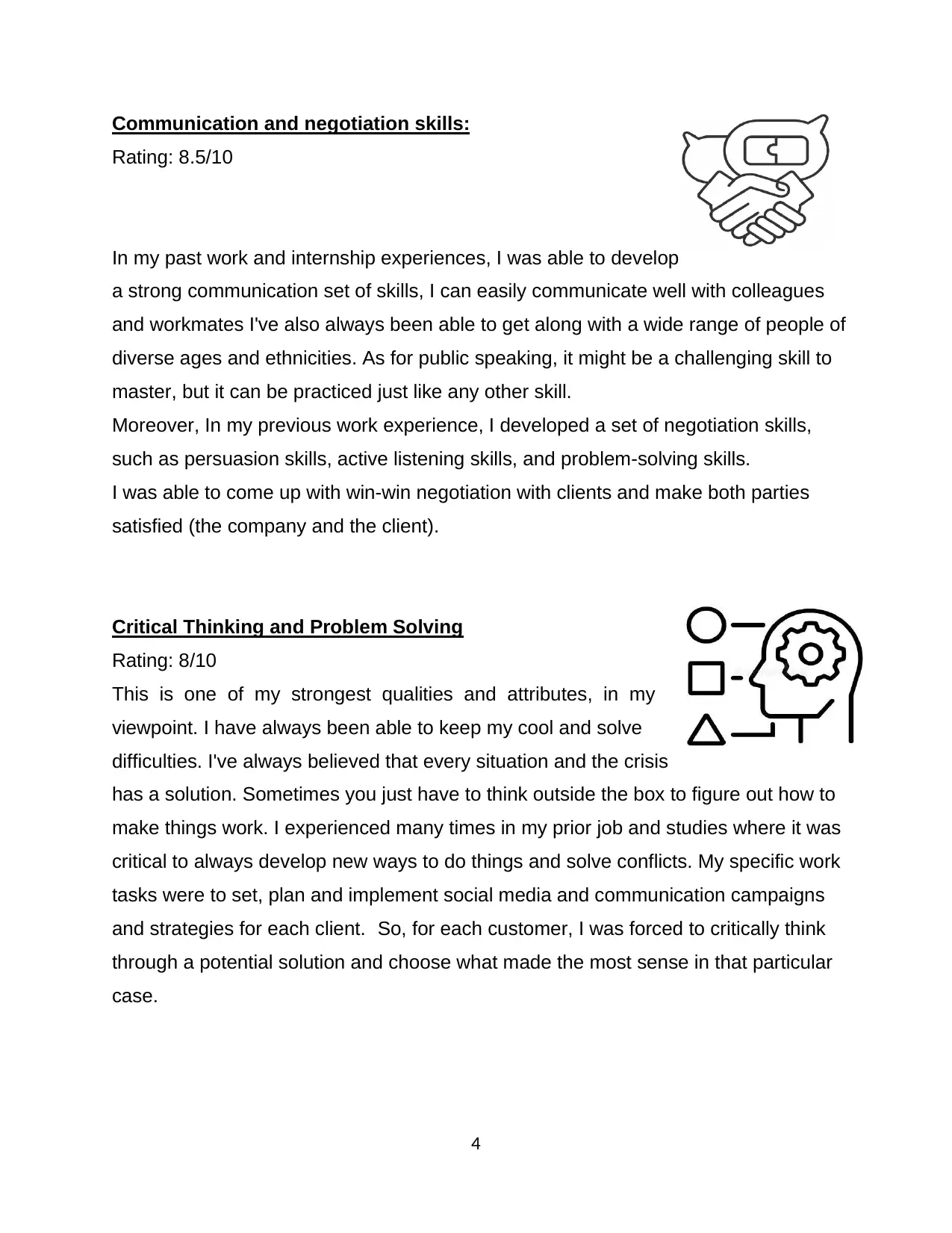
4
Communication and negotiation skills:
Rating: 8.5/10
In my past work and internship experiences, I was able to develop
a strong communication set of skills, I can easily communicate well with colleagues
and workmates I've also always been able to get along with a wide range of people of
diverse ages and ethnicities. As for public speaking, it might be a challenging skill to
master, but it can be practiced just like any other skill.
Moreover, In my previous work experience, I developed a set of negotiation skills,
such as persuasion skills, active listening skills, and problem-solving skills.
I was able to come up with win-win negotiation with clients and make both parties
satisfied (the company and the client).
Critical Thinking and Problem Solving
Rating: 8/10
This is one of my strongest qualities and attributes, in my
viewpoint. I have always been able to keep my cool and solve
difficulties. I've always believed that every situation and the crisis
has a solution. Sometimes you just have to think outside the box to figure out how to
make things work. I experienced many times in my prior job and studies where it was
critical to always develop new ways to do things and solve conflicts. My specific work
tasks were to set, plan and implement social media and communication campaigns
and strategies for each client. So, for each customer, I was forced to critically think
through a potential solution and choose what made the most sense in that particular
case.
Communication and negotiation skills:
Rating: 8.5/10
In my past work and internship experiences, I was able to develop
a strong communication set of skills, I can easily communicate well with colleagues
and workmates I've also always been able to get along with a wide range of people of
diverse ages and ethnicities. As for public speaking, it might be a challenging skill to
master, but it can be practiced just like any other skill.
Moreover, In my previous work experience, I developed a set of negotiation skills,
such as persuasion skills, active listening skills, and problem-solving skills.
I was able to come up with win-win negotiation with clients and make both parties
satisfied (the company and the client).
Critical Thinking and Problem Solving
Rating: 8/10
This is one of my strongest qualities and attributes, in my
viewpoint. I have always been able to keep my cool and solve
difficulties. I've always believed that every situation and the crisis
has a solution. Sometimes you just have to think outside the box to figure out how to
make things work. I experienced many times in my prior job and studies where it was
critical to always develop new ways to do things and solve conflicts. My specific work
tasks were to set, plan and implement social media and communication campaigns
and strategies for each client. So, for each customer, I was forced to critically think
through a potential solution and choose what made the most sense in that particular
case.
Paraphrase This Document
Need a fresh take? Get an instant paraphrase of this document with our AI Paraphraser
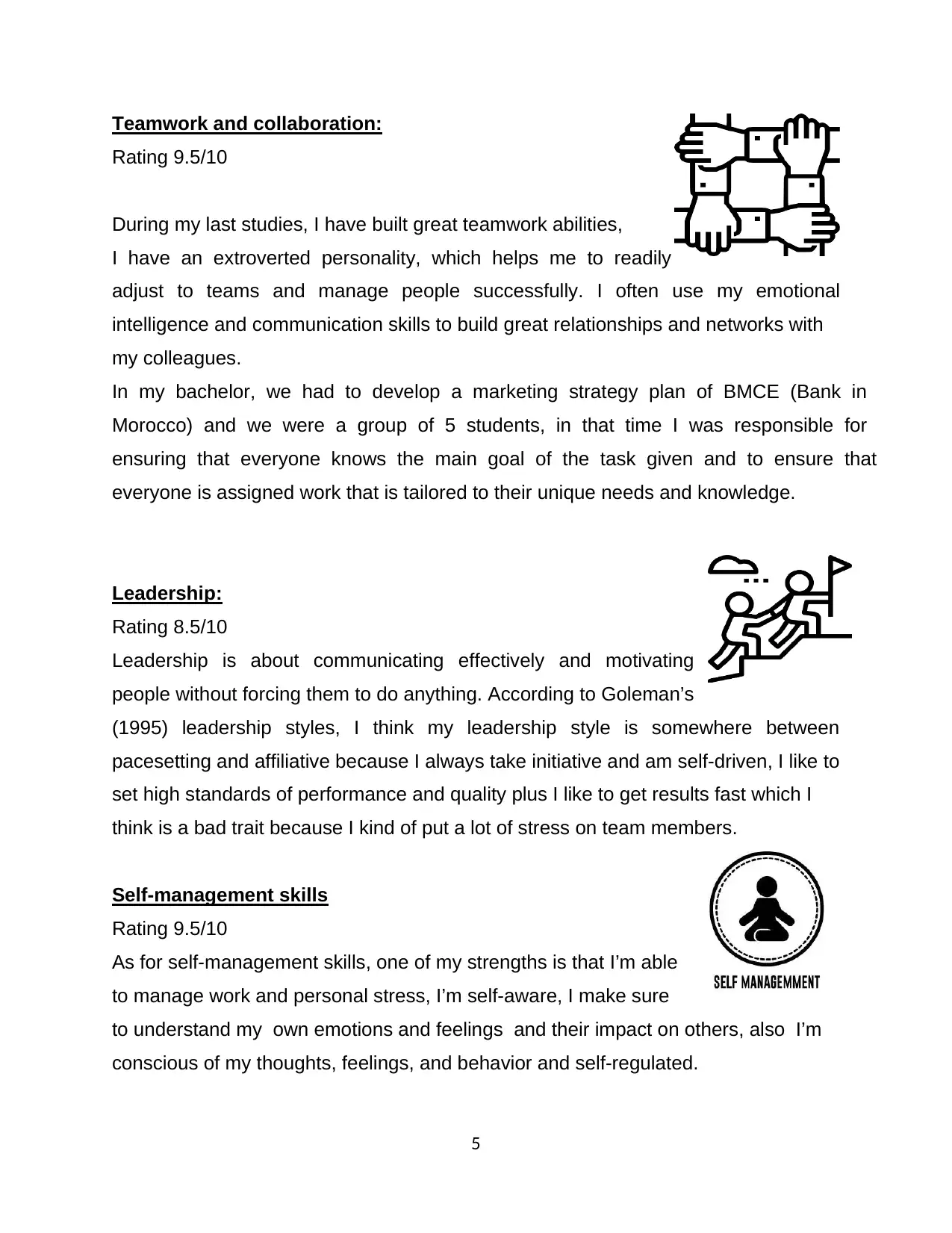
5
Teamwork and collaboration:
Rating 9.5/10
During my last studies, I have built great teamwork abilities,
I have an extroverted personality, which helps me to readily
adjust to teams and manage people successfully. I often use my emotional
intelligence and communication skills to build great relationships and networks with
my colleagues.
In my bachelor, we had to develop a marketing strategy plan of BMCE (Bank in
Morocco) and we were a group of 5 students, in that time I was responsible for
ensuring that everyone knows the main goal of the task given and to ensure that
everyone is assigned work that is tailored to their unique needs and knowledge.
Leadership:
Rating 8.5/10
Leadership is about communicating effectively and motivating
people without forcing them to do anything. According to Goleman’s
(1995) leadership styles, I think my leadership style is somewhere between
pacesetting and affiliative because I always take initiative and am self-driven, I like to
set high standards of performance and quality plus I like to get results fast which I
think is a bad trait because I kind of put a lot of stress on team members.
Self-management skills
Rating 9.5/10
As for self-management skills, one of my strengths is that I’m able
to manage work and personal stress, I’m self-aware, I make sure
to understand my own emotions and feelings and their impact on others, also I’m
conscious of my thoughts, feelings, and behavior and self-regulated.
Teamwork and collaboration:
Rating 9.5/10
During my last studies, I have built great teamwork abilities,
I have an extroverted personality, which helps me to readily
adjust to teams and manage people successfully. I often use my emotional
intelligence and communication skills to build great relationships and networks with
my colleagues.
In my bachelor, we had to develop a marketing strategy plan of BMCE (Bank in
Morocco) and we were a group of 5 students, in that time I was responsible for
ensuring that everyone knows the main goal of the task given and to ensure that
everyone is assigned work that is tailored to their unique needs and knowledge.
Leadership:
Rating 8.5/10
Leadership is about communicating effectively and motivating
people without forcing them to do anything. According to Goleman’s
(1995) leadership styles, I think my leadership style is somewhere between
pacesetting and affiliative because I always take initiative and am self-driven, I like to
set high standards of performance and quality plus I like to get results fast which I
think is a bad trait because I kind of put a lot of stress on team members.
Self-management skills
Rating 9.5/10
As for self-management skills, one of my strengths is that I’m able
to manage work and personal stress, I’m self-aware, I make sure
to understand my own emotions and feelings and their impact on others, also I’m
conscious of my thoughts, feelings, and behavior and self-regulated.
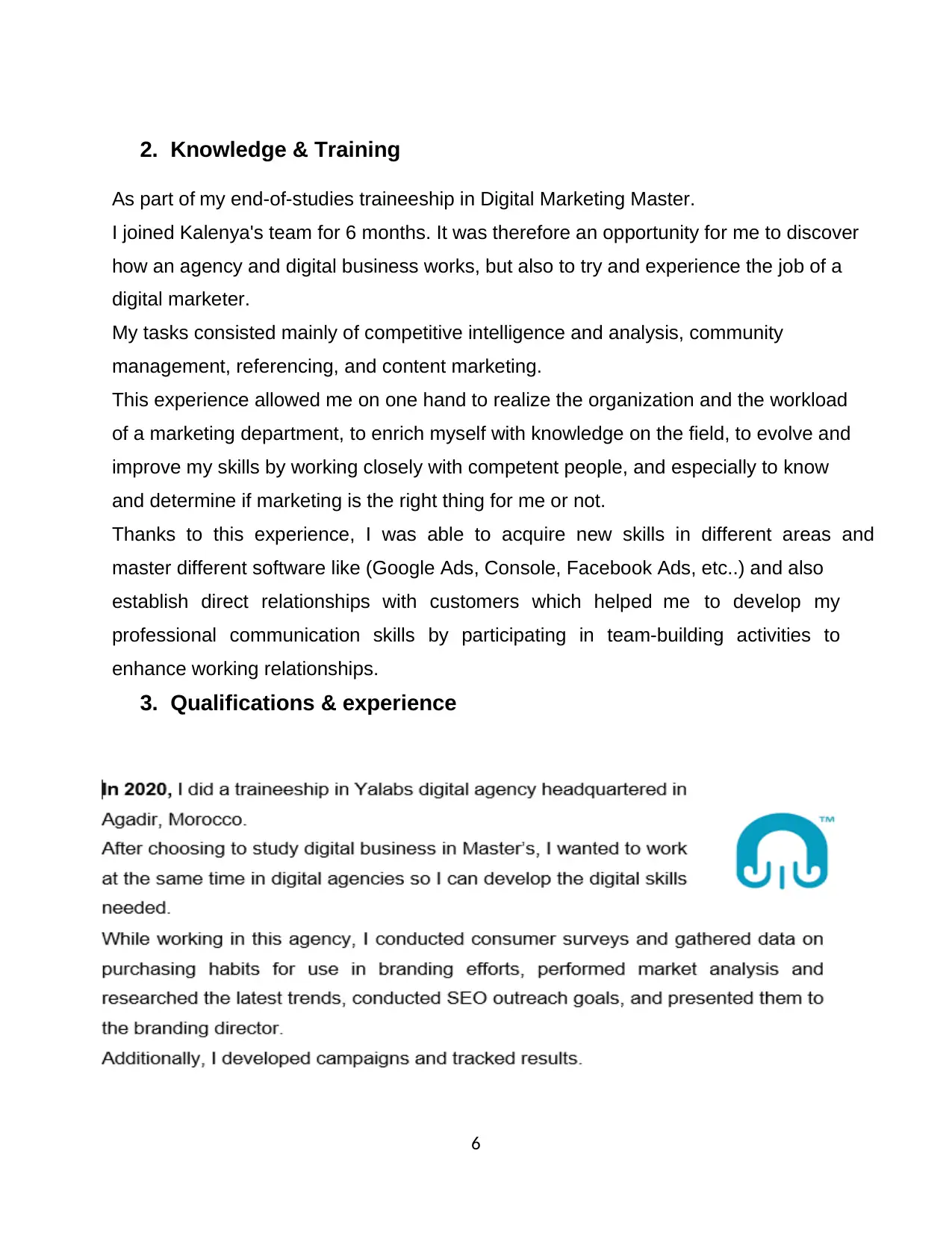
6
2. Knowledge & Training
As part of my end-of-studies traineeship in Digital Marketing Master.
I joined Kalenya's team for 6 months. It was therefore an opportunity for me to discover
how an agency and digital business works, but also to try and experience the job of a
digital marketer.
My tasks consisted mainly of competitive intelligence and analysis, community
management, referencing, and content marketing.
This experience allowed me on one hand to realize the organization and the workload
of a marketing department, to enrich myself with knowledge on the field, to evolve and
improve my skills by working closely with competent people, and especially to know
and determine if marketing is the right thing for me or not.
Thanks to this experience, I was able to acquire new skills in different areas and
master different software like (Google Ads, Console, Facebook Ads, etc..) and also
establish direct relationships with customers which helped me to develop my
professional communication skills by participating in team-building activities to
enhance working relationships.
3. Qualifications & experience
2. Knowledge & Training
As part of my end-of-studies traineeship in Digital Marketing Master.
I joined Kalenya's team for 6 months. It was therefore an opportunity for me to discover
how an agency and digital business works, but also to try and experience the job of a
digital marketer.
My tasks consisted mainly of competitive intelligence and analysis, community
management, referencing, and content marketing.
This experience allowed me on one hand to realize the organization and the workload
of a marketing department, to enrich myself with knowledge on the field, to evolve and
improve my skills by working closely with competent people, and especially to know
and determine if marketing is the right thing for me or not.
Thanks to this experience, I was able to acquire new skills in different areas and
master different software like (Google Ads, Console, Facebook Ads, etc..) and also
establish direct relationships with customers which helped me to develop my
professional communication skills by participating in team-building activities to
enhance working relationships.
3. Qualifications & experience
⊘ This is a preview!⊘
Do you want full access?
Subscribe today to unlock all pages.

Trusted by 1+ million students worldwide
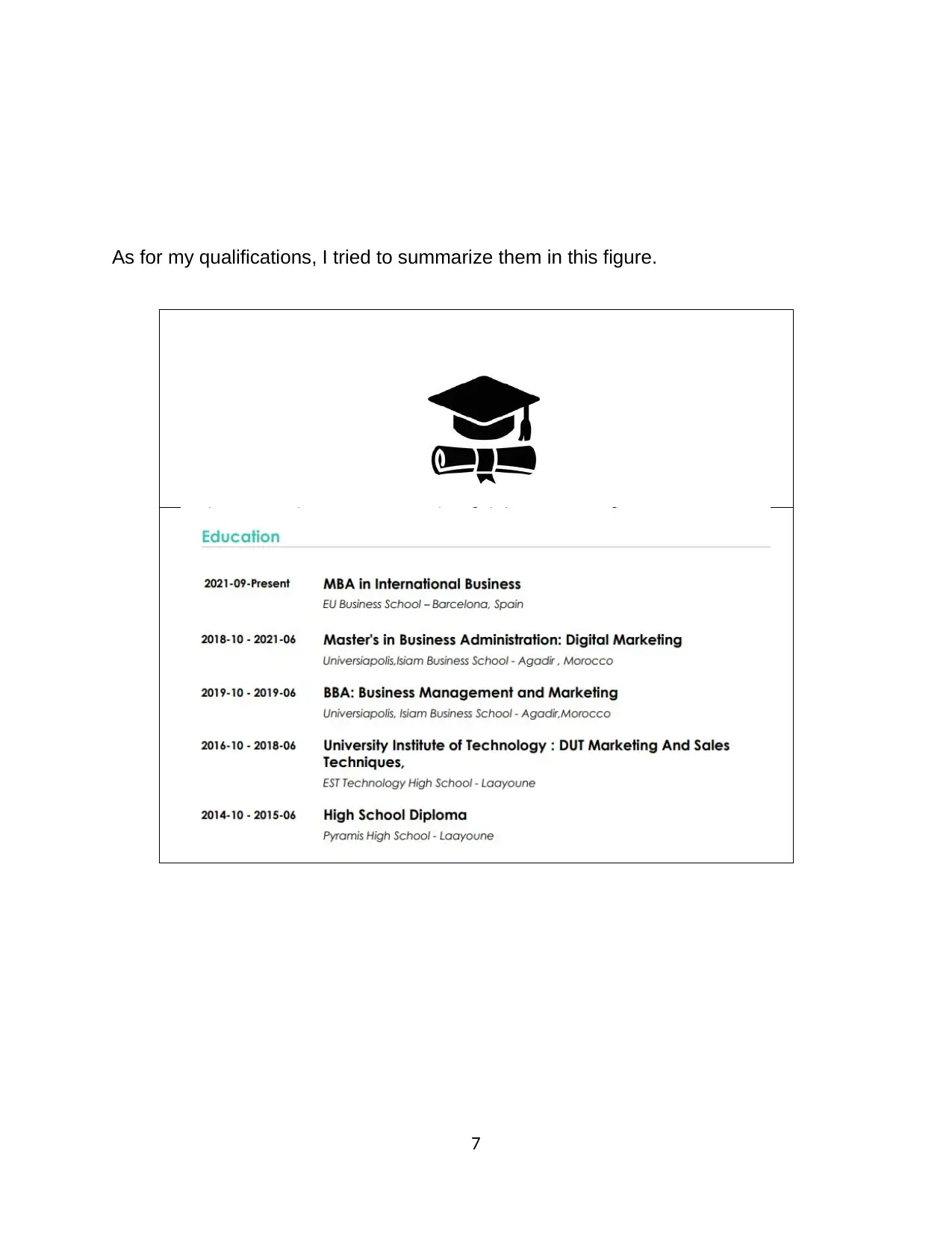
7
As for my qualifications, I tried to summarize them in this figure.
As for my qualifications, I tried to summarize them in this figure.
Paraphrase This Document
Need a fresh take? Get an instant paraphrase of this document with our AI Paraphraser
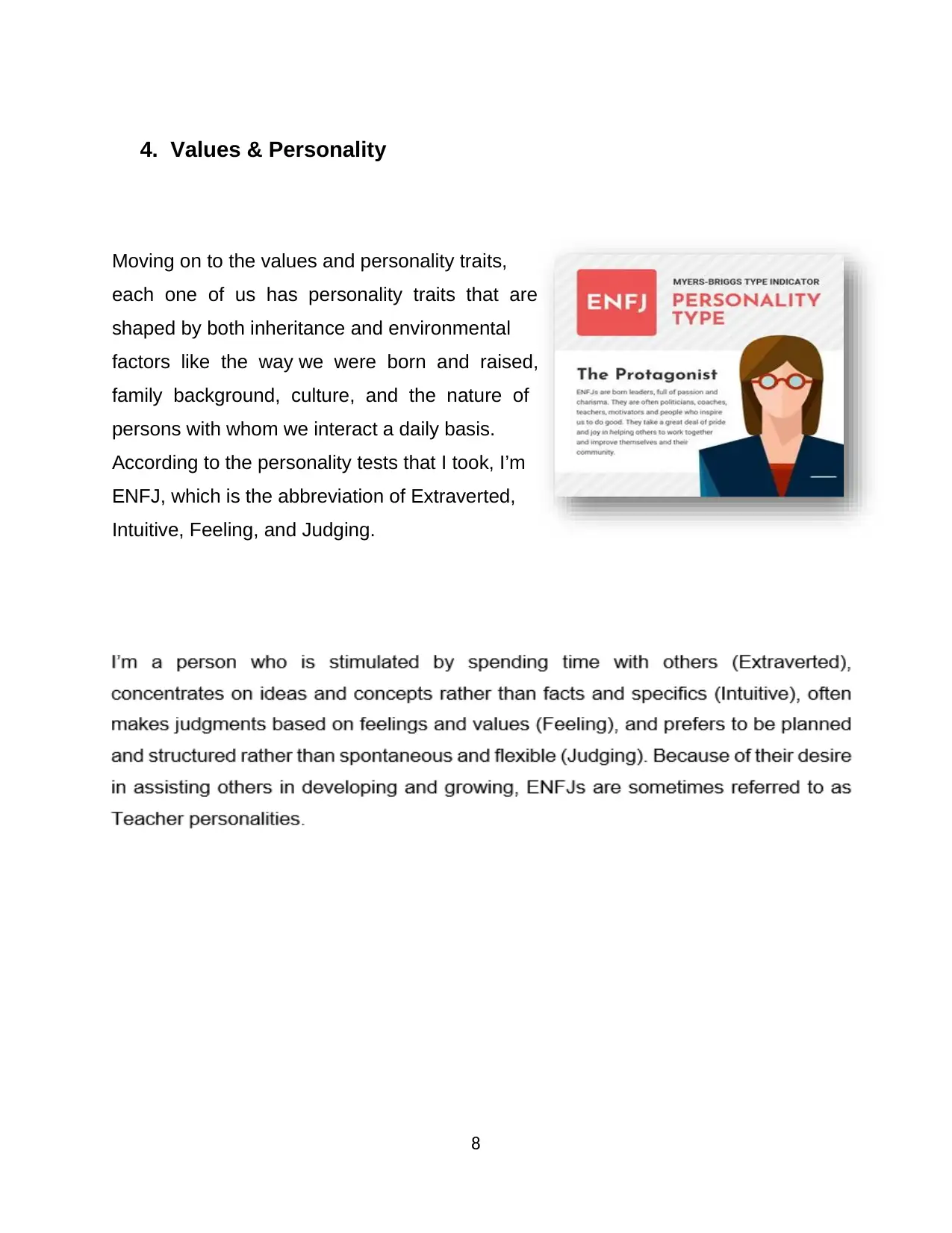
8
4. Values & Personality
Moving on to the values and personality traits,
each one of us has personality traits that are
shaped by both inheritance and environmental
factors like the way we were born and raised,
family background, culture, and the nature of
persons with whom we interact a daily basis.
According to the personality tests that I took, I’m
ENFJ, which is the abbreviation of Extraverted,
Intuitive, Feeling, and Judging.
4. Values & Personality
Moving on to the values and personality traits,
each one of us has personality traits that are
shaped by both inheritance and environmental
factors like the way we were born and raised,
family background, culture, and the nature of
persons with whom we interact a daily basis.
According to the personality tests that I took, I’m
ENFJ, which is the abbreviation of Extraverted,
Intuitive, Feeling, and Judging.

9
As for what I value the most:
As for what I value the most:
⊘ This is a preview!⊘
Do you want full access?
Subscribe today to unlock all pages.

Trusted by 1+ million students worldwide
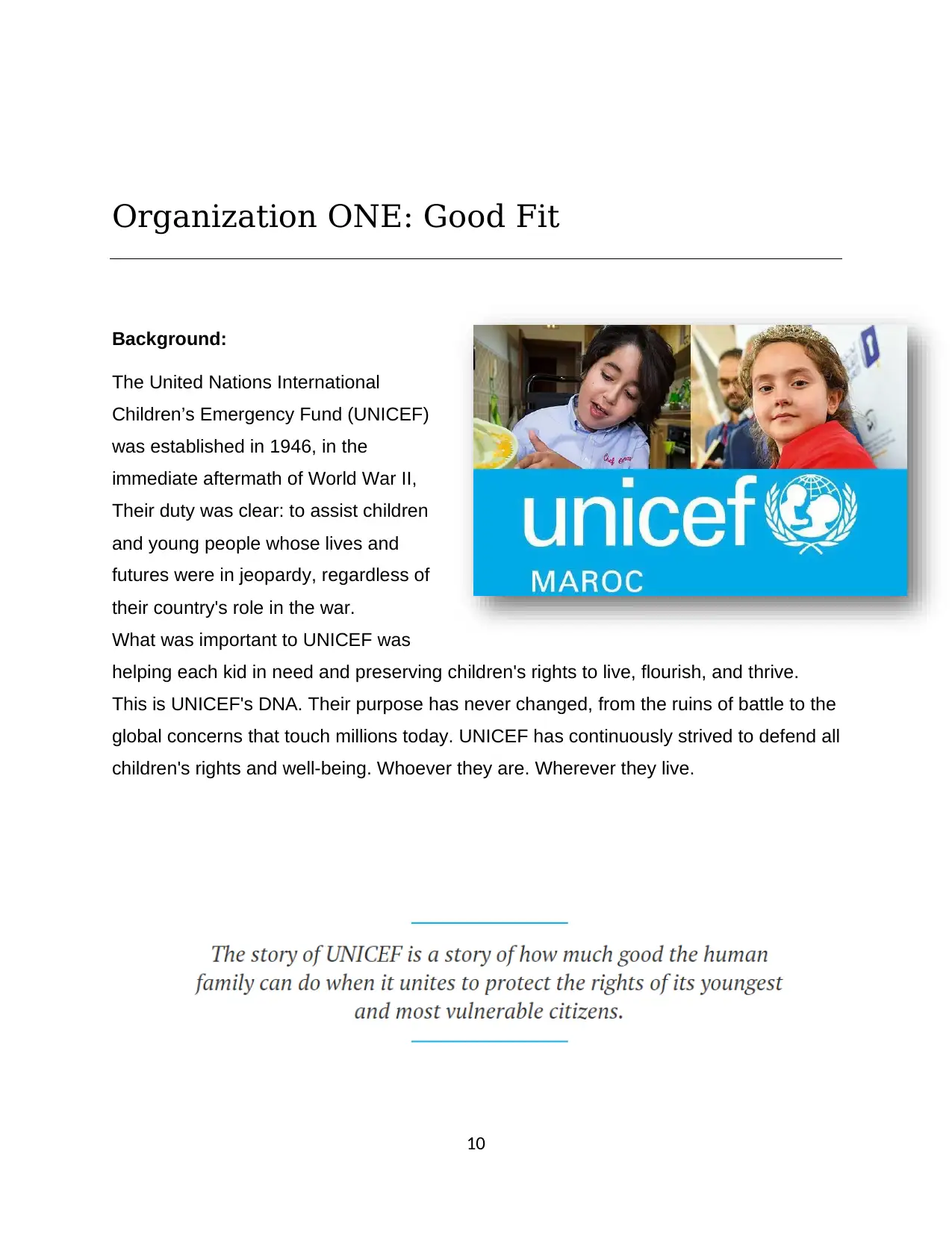
10
Organization ONE: Good Fit
Background:
The United Nations International
Children’s Emergency Fund (UNICEF)
was established in 1946, in the
immediate aftermath of World War II,
Their duty was clear: to assist children
and young people whose lives and
futures were in jeopardy, regardless of
their country's role in the war.
What was important to UNICEF was
helping each kid in need and preserving children's rights to live, flourish, and thrive.
This is UNICEF's DNA. Their purpose has never changed, from the ruins of battle to the
global concerns that touch millions today. UNICEF has continuously strived to defend all
children's rights and well-being. Whoever they are. Wherever they live.
Organization ONE: Good Fit
Background:
The United Nations International
Children’s Emergency Fund (UNICEF)
was established in 1946, in the
immediate aftermath of World War II,
Their duty was clear: to assist children
and young people whose lives and
futures were in jeopardy, regardless of
their country's role in the war.
What was important to UNICEF was
helping each kid in need and preserving children's rights to live, flourish, and thrive.
This is UNICEF's DNA. Their purpose has never changed, from the ruins of battle to the
global concerns that touch millions today. UNICEF has continuously strived to defend all
children's rights and well-being. Whoever they are. Wherever they live.
Paraphrase This Document
Need a fresh take? Get an instant paraphrase of this document with our AI Paraphraser
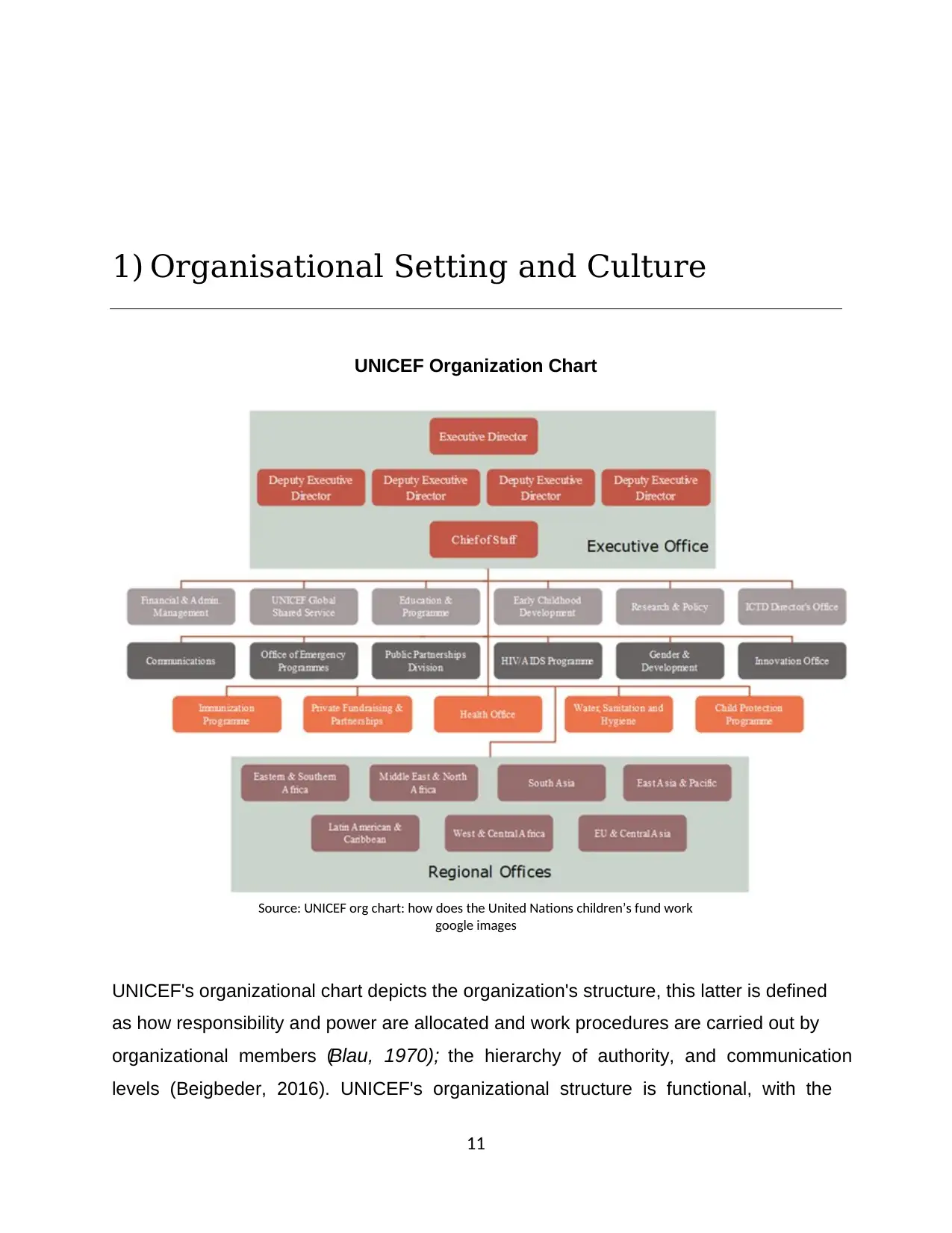
11
1) Organisational Setting and Culture
UNICEF Organization Chart
Source: UNICEF org chart: how does the United Nations children’s fund work
google images
UNICEF's organizational chart depicts the organization's structure, this latter is defined
as how responsibility and power are allocated and work procedures are carried out by
organizational members (Blau, 1970); the hierarchy of authority, and communication
levels (Beigbeder, 2016). UNICEF's organizational structure is functional, with the
1) Organisational Setting and Culture
UNICEF Organization Chart
Source: UNICEF org chart: how does the United Nations children’s fund work
google images
UNICEF's organizational chart depicts the organization's structure, this latter is defined
as how responsibility and power are allocated and work procedures are carried out by
organizational members (Blau, 1970); the hierarchy of authority, and communication
levels (Beigbeder, 2016). UNICEF's organizational structure is functional, with the
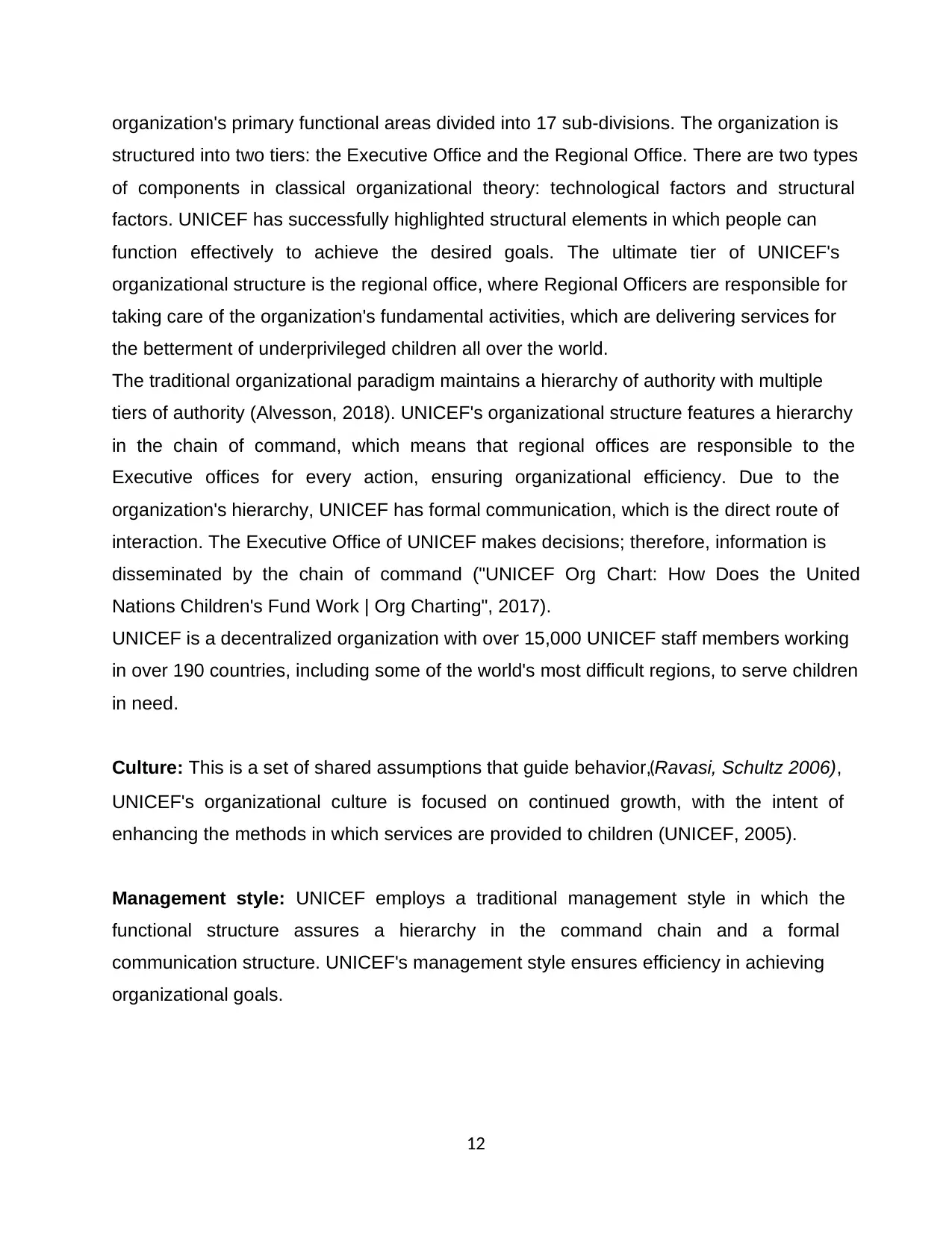
12
organization's primary functional areas divided into 17 sub-divisions. The organization is
structured into two tiers: the Executive Office and the Regional Office. There are two types
of components in classical organizational theory: technological factors and structural
factors. UNICEF has successfully highlighted structural elements in which people can
function effectively to achieve the desired goals. The ultimate tier of UNICEF's
organizational structure is the regional office, where Regional Officers are responsible for
taking care of the organization's fundamental activities, which are delivering services for
the betterment of underprivileged children all over the world.
The traditional organizational paradigm maintains a hierarchy of authority with multiple
tiers of authority (Alvesson, 2018). UNICEF's organizational structure features a hierarchy
in the chain of command, which means that regional offices are responsible to the
Executive offices for every action, ensuring organizational efficiency. Due to the
organization's hierarchy, UNICEF has formal communication, which is the direct route of
interaction. The Executive Office of UNICEF makes decisions; therefore, information is
disseminated by the chain of command ("UNICEF Org Chart: How Does the United
Nations Children's Fund Work | Org Charting", 2017).
UNICEF is a decentralized organization with over 15,000 UNICEF staff members working
in over 190 countries, including some of the world's most difficult regions, to serve children
in need.
Culture: This is a set of shared assumptions that guide behavior,(Ravasi, Schultz 2006),
UNICEF's organizational culture is focused on continued growth, with the intent of
enhancing the methods in which services are provided to children (UNICEF, 2005).
Management style: UNICEF employs a traditional management style in which the
functional structure assures a hierarchy in the command chain and a formal
communication structure. UNICEF's management style ensures efficiency in achieving
organizational goals.
organization's primary functional areas divided into 17 sub-divisions. The organization is
structured into two tiers: the Executive Office and the Regional Office. There are two types
of components in classical organizational theory: technological factors and structural
factors. UNICEF has successfully highlighted structural elements in which people can
function effectively to achieve the desired goals. The ultimate tier of UNICEF's
organizational structure is the regional office, where Regional Officers are responsible for
taking care of the organization's fundamental activities, which are delivering services for
the betterment of underprivileged children all over the world.
The traditional organizational paradigm maintains a hierarchy of authority with multiple
tiers of authority (Alvesson, 2018). UNICEF's organizational structure features a hierarchy
in the chain of command, which means that regional offices are responsible to the
Executive offices for every action, ensuring organizational efficiency. Due to the
organization's hierarchy, UNICEF has formal communication, which is the direct route of
interaction. The Executive Office of UNICEF makes decisions; therefore, information is
disseminated by the chain of command ("UNICEF Org Chart: How Does the United
Nations Children's Fund Work | Org Charting", 2017).
UNICEF is a decentralized organization with over 15,000 UNICEF staff members working
in over 190 countries, including some of the world's most difficult regions, to serve children
in need.
Culture: This is a set of shared assumptions that guide behavior,(Ravasi, Schultz 2006),
UNICEF's organizational culture is focused on continued growth, with the intent of
enhancing the methods in which services are provided to children (UNICEF, 2005).
Management style: UNICEF employs a traditional management style in which the
functional structure assures a hierarchy in the command chain and a formal
communication structure. UNICEF's management style ensures efficiency in achieving
organizational goals.
⊘ This is a preview!⊘
Do you want full access?
Subscribe today to unlock all pages.

Trusted by 1+ million students worldwide
1 out of 24
Related Documents
Your All-in-One AI-Powered Toolkit for Academic Success.
+13062052269
info@desklib.com
Available 24*7 on WhatsApp / Email
![[object Object]](/_next/static/media/star-bottom.7253800d.svg)
Unlock your academic potential
Copyright © 2020–2025 A2Z Services. All Rights Reserved. Developed and managed by ZUCOL.




